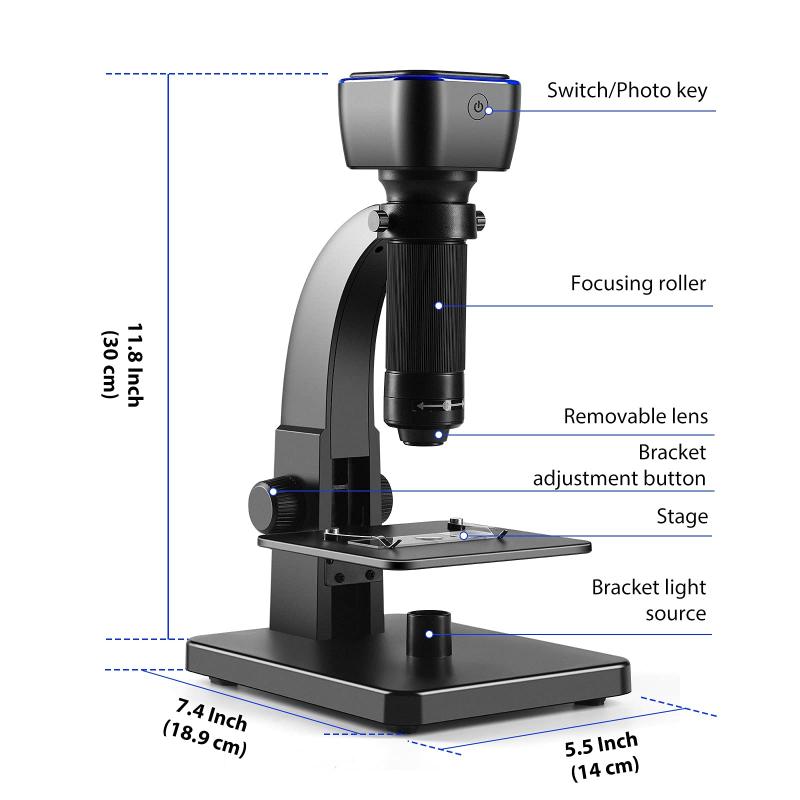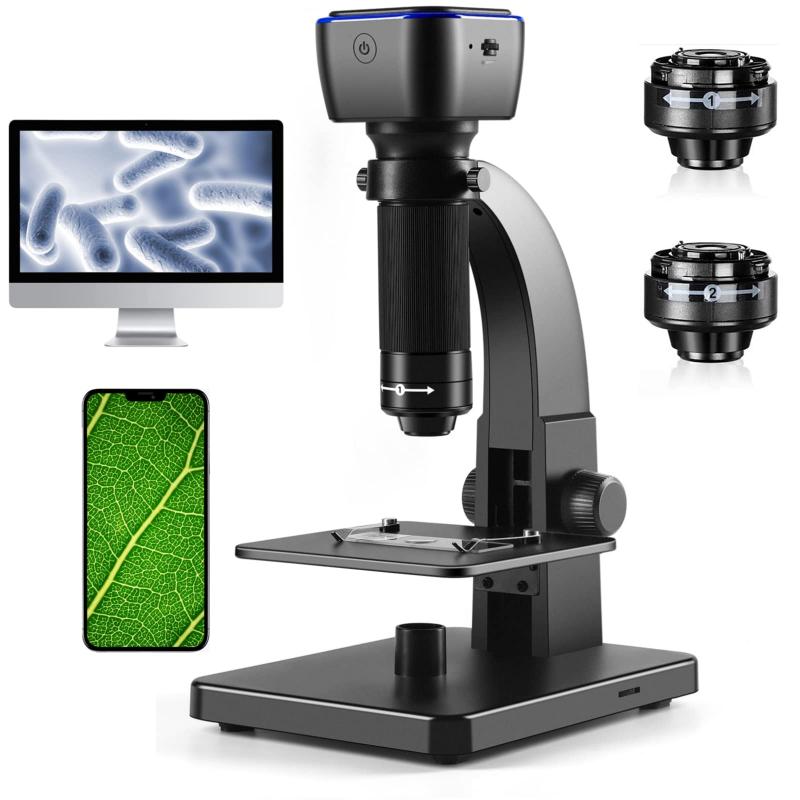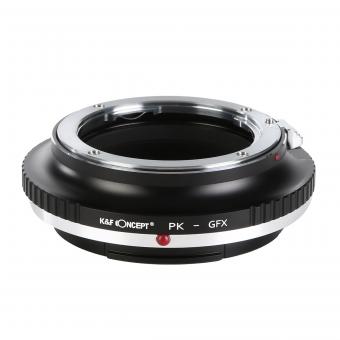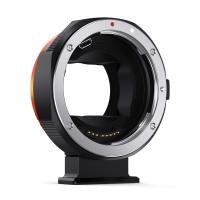Why Electron Microscope Are Better Than Light ?
Electron microscopes are better than light microscopes because they use a beam of electrons instead of light to magnify and visualize specimens. This allows for much higher resolution and greater detail in the images produced. Electron microscopes have a much shorter wavelength than light, which enables them to achieve much higher magnification and resolution. Additionally, electron microscopes can reveal the internal structure of specimens, as they have the ability to penetrate through materials and provide a three-dimensional view. This makes electron microscopes particularly useful for studying the ultrastructure of cells, viruses, and other small particles.
1、 Higher resolution for imaging small structures
Electron microscopes are better than light microscopes due to their higher resolution for imaging small structures. This is primarily because of the fundamental differences in the way these two types of microscopes work.
Light microscopes use visible light to illuminate the specimen, and the resolution is limited by the wavelength of light. The wavelength of visible light ranges from 400 to 700 nanometers, which means that it can only resolve structures that are larger than this limit. On the other hand, electron microscopes use a beam of electrons to illuminate the specimen, and the resolution is determined by the wavelength of electrons. Electrons have much shorter wavelengths, typically ranging from 0.005 to 0.2 nanometers, allowing electron microscopes to resolve much smaller structures.
The higher resolution of electron microscopes enables scientists to study the fine details of cells, tissues, and even individual molecules. This has been crucial in various fields of research, such as biology, materials science, and nanotechnology. For example, electron microscopes have been instrumental in understanding the intricate structures of viruses, the arrangement of atoms in materials, and the development of new nanoscale devices.
Moreover, recent advancements in electron microscopy techniques have further enhanced their capabilities. For instance, the development of cryo-electron microscopy (cryo-EM) has revolutionized the field of structural biology. Cryo-EM allows scientists to visualize biomolecules in their native state, without the need for staining or fixing, providing unprecedented insights into their structure and function.
In conclusion, electron microscopes are superior to light microscopes due to their higher resolution for imaging small structures. The ability to visualize and study objects at the nanoscale has significantly advanced our understanding of the natural world and has opened up new avenues for scientific exploration.

2、 Ability to visualize objects below the diffraction limit
Electron microscopes are better than light microscopes primarily due to their ability to visualize objects below the diffraction limit. This is because the wavelength of electrons used in electron microscopes is much smaller than the wavelength of visible light used in light microscopes. According to the diffraction limit, the resolution of a microscope is limited by the wavelength of the radiation used to image the specimen. As the wavelength decreases, the resolution improves.
In light microscopes, the diffraction limit restricts the resolution to around 200-300 nanometers, which means that objects smaller than this limit cannot be clearly visualized. On the other hand, electron microscopes use a beam of electrons with a much smaller wavelength, allowing them to achieve resolutions in the range of a few picometers to a few nanometers. This enables scientists to observe and study structures at the atomic and molecular level, providing detailed information about the arrangement and composition of materials.
Moreover, recent advancements in electron microscopy techniques have further enhanced their capabilities. For example, the development of aberration-corrected electron microscopy has significantly improved the resolution and image quality. This technique corrects for the aberrations caused by the electromagnetic lenses in the microscope, allowing for sharper and more detailed images.
Additionally, electron microscopes can also provide valuable information about the chemical composition of a specimen through techniques such as energy-dispersive X-ray spectroscopy (EDS) and electron energy loss spectroscopy (EELS). These techniques allow researchers to analyze the elemental composition and chemical bonding within a sample, providing insights into its properties and behavior.
In conclusion, electron microscopes are superior to light microscopes due to their ability to visualize objects below the diffraction limit. The smaller wavelength of electrons enables higher resolution imaging, allowing scientists to study structures at the atomic and molecular level. With recent advancements in electron microscopy techniques, their capabilities have been further enhanced, making them indispensable tools in various scientific fields.

3、 Enhanced depth of field for three-dimensional imaging
Electron microscopes are better than light microscopes due to several reasons, one of which is their enhanced depth of field for three-dimensional imaging. This feature allows electron microscopes to capture detailed images of objects with greater clarity and precision.
The enhanced depth of field in electron microscopes is achieved through a technique called focus stacking. This process involves capturing a series of images at different focal planes and then combining them to create a single image with a greater depth of field. This technique enables electron microscopes to capture three-dimensional images of objects with intricate details, such as the surface texture of a cell or the fine structure of a material.
In contrast, light microscopes have limitations in their depth of field, which can result in blurred or out-of-focus images when imaging objects with complex three-dimensional structures. This is because light microscopes rely on the bending of light waves to form an image, and the bending of light limits the depth of field that can be achieved.
Furthermore, electron microscopes have a much higher resolution compared to light microscopes. This is due to the shorter wavelength of electrons, which allows for the visualization of smaller details. The latest advancements in electron microscopy, such as the development of aberration-corrected electron lenses, have further improved the resolution and image quality.
In summary, electron microscopes are better than light microscopes for three-dimensional imaging due to their enhanced depth of field. This capability, along with their higher resolution, allows electron microscopes to provide detailed and accurate images of objects with complex structures. As technology continues to advance, electron microscopy is expected to play an increasingly important role in various scientific fields, including biology, materials science, and nanotechnology.

4、 Greater magnification capabilities
Electron microscopes are better than light microscopes due to their greater magnification capabilities. Electron microscopes use a beam of electrons instead of light to magnify the specimen, allowing for much higher resolution and magnification. This is because electrons have a much shorter wavelength than light, enabling them to resolve smaller details and provide a clearer image.
The magnification capabilities of electron microscopes are significantly higher than those of light microscopes. Light microscopes typically have a maximum magnification of around 2000x, while electron microscopes can achieve magnifications of up to several million times. This allows scientists to observe and study structures at the atomic and molecular level, providing valuable insights into the composition and behavior of materials.
Furthermore, electron microscopes offer various imaging techniques that enhance the visualization of specimens. For example, scanning electron microscopy (SEM) provides a three-dimensional view of the surface of a specimen, allowing for detailed analysis of its topography. Transmission electron microscopy (TEM) allows scientists to study the internal structure of a specimen by passing electrons through it.
In recent years, advancements in electron microscopy technology have further improved its capabilities. For instance, the development of aberration-corrected electron microscopy has significantly enhanced the resolution and image quality. Additionally, the integration of electron microscopy with other techniques, such as spectroscopy and tomography, has expanded the range of applications and enabled more comprehensive analysis.
In conclusion, electron microscopes are superior to light microscopes due to their greater magnification capabilities. The ability to achieve higher resolutions and magnifications allows scientists to explore the microscopic world in unprecedented detail. With ongoing advancements in electron microscopy technology, researchers can continue to push the boundaries of scientific understanding and make new discoveries in various fields, including materials science, biology, and nanotechnology.








































